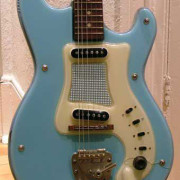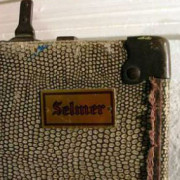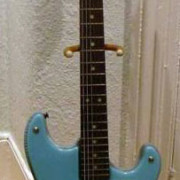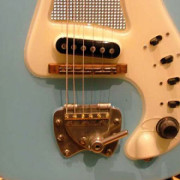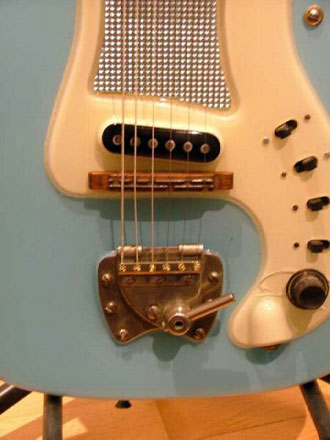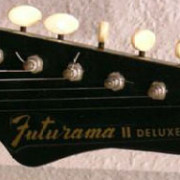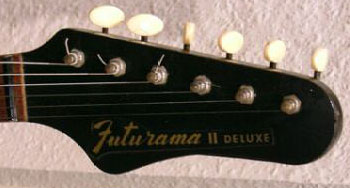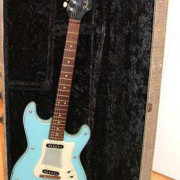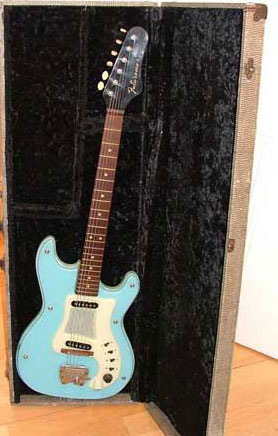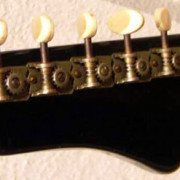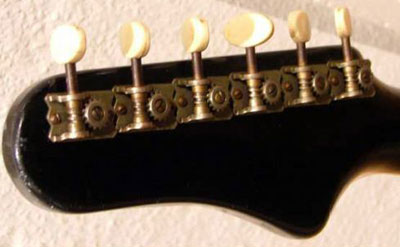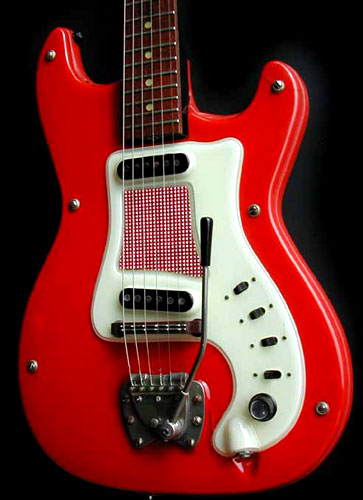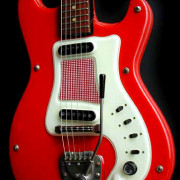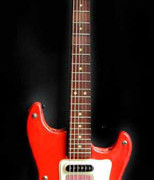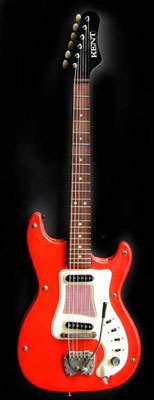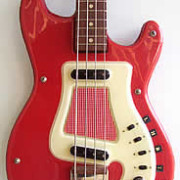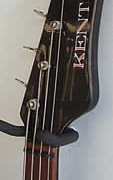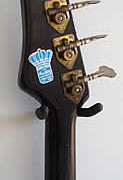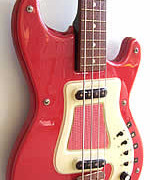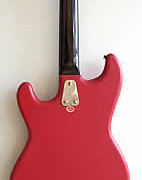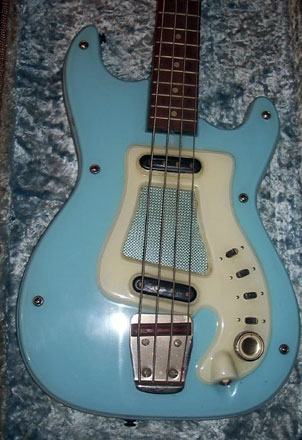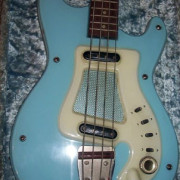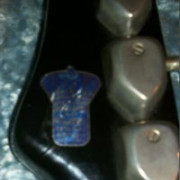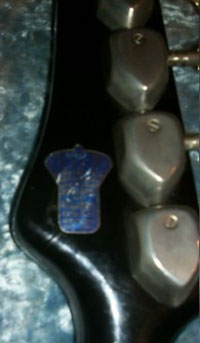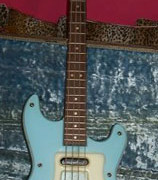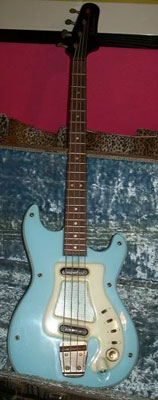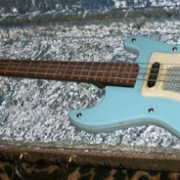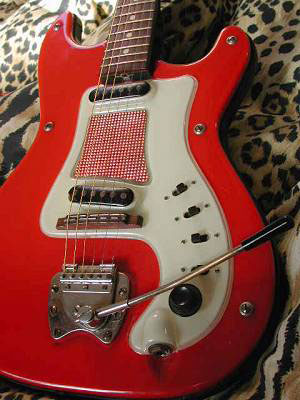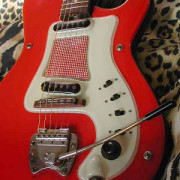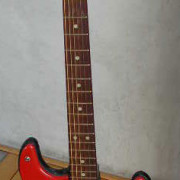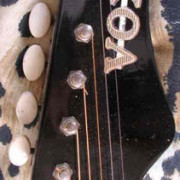1963 Futurama II Deluxe
Vibrato arm is missing and one strap button has been changed, but aside from that this sweet baby blue baby is entirely original and is graced by its no less original hard shell case from Selmer UK.
Here Hagström uses for the first time a Fender-style nut, inserted into the fretboard wood. A solution that was not allowed previously by the plastic fretboards of the DeLuxe/Standard and earliest Corvette/Impala series.
Leva vibrato assente e una reggicinghia cambiata, ma a parte questi dettagli ecco una carina bimba vestita in blu bébé, tutta originale, gratificata di una non meno originale custodia rigida di Selmer UK.
Qui la Hagström inaugura l’uso d’un capotasto alla Fender, inserito nel legno della tastiera. Una soluzione che in precedenza non era consentito dlle tastiere di plastica delle Deluxe/Standard e delle primissime Corvette/Impala.
Levier vibrato absent et un bouton de sangle changé, mais à ces détails près ce joli bébé en bleu layette est totalement original et bénéficie d’un non moins original étui rigide de Selmer UK.
Ici, Hagström emploie pour la première fois un sillet style Fender, serti dans le bois de la touche. Une solution que jusque là ne permettaient pas les touches en plastique des Deluxe/Standard et des premières Corvette/Impala.
1963 Kent
Most Kents with a Kent logo are to be found in Sweden, then in neighbouring Scandinavian countries, and a few ones sometimes show up elsewhere in Western Europe. We don’t know how this one managed to travel to the other side of the globe but anyway it is currrently in Australia, and is likely to be the only one of its kind down there.
Warning to the next owner : if you are a bit familiar with Hagström guitars you might be suprised by the logo on headstock, by the red-tinted grille, by the vibrato arm that is not like the usual type, by the pinned string fastening system — do not change anything, it is all original!
There is also the ‘King’s Neck’ sticker on the back of the headstock. A piece of black celluloid nearby is gone, no big deal, nothing to haggle over. All in all this guitar is a gem. To find a Kent from this generation in this condition is a true miracle. Think that for this primitive version of the vibrato, it is impossible to find new-old-stock spares for the vibrato arm and the string pins, or even only repros.
La maggioranza delle Kent con logo Kent si trovano in Svezia, in secondo luogo negli altri paesi scandinavi, e alcune appaiono ogni tanto altrove in Europa occidentale. Non sappiamo come mai questa qui è finita agli antipodi ma comunque ora è domiciliata in Australia, e magari potrebbe essere l’unica della sua specie da quelle parti.
Avvertenza al prossimo proprietario: se ha un po’ di familiarità con le Hagström può darsi che sarà sorpreso da questo logo sulla paletta, dalla griglia colorata in rosso, dalla leva vibrato diversa dal solito tipo, dai piroli che fissano le corde — non si deve cambiare niente, è tutta originale!
C’è anche l’adesivo ‘King’s Neck’ dietro la paletta. Un pezzo di celluloide nero accanto è andato via, niente di grave, non è il caso di litigare. Questa chitarra è complessivamente un gioiello. Reperire una Kent di questa generazione in tali condizioni è un vero miracolo. Pensate che per questa versione primitiva del vibrato, è impossibile trovare sia componenti new-old-stock che riproduzioni, per la leva ed i piroli.
La plupart des Kents à logo Kent se trouvent en Suède, puis dans les pays scandinaves voisins, et quelques unes se voient parfois ailleurs en Europe de l’Ouest. Nous ne savons pas comment celle-ci s’est retrouvée aux antipodes mais en tous cas elle réside présentement en Australie et pourrait bien être seule de son espèce là-bas.
Avis au prochain possesseur : si vous êtes un peu familier des Hagström vous risquez d’être surpris par ce logo sur la tête, cette grille colorée en rouge, ce manche de vibrato différent du type habituel, la fixation des cordes par chevilles — ne changez rien, tout est original !
Il y a aussi le label ‘King’s Neck’ au revers de la tête. Un bout de celluloïd noir à côté est parti, rien de grave, pas de quoi chipoter. Trouver une Kent de cette génération dans cet état est un vrai miracle. Pensez que que pour cette version primitive du vibrato il est impossible pour le levier et les goupilles de trouver des pièces new-old-stock, ou même des repros.
1963 Kent bass
This instrument exactly duplicates in bass version all features of the six-stringed Kent on previous page: same generation, same Kent logo on headstock, same ‘King’s Neck’ label on the other side, same red-coloured aluminium grille between the pickups… Furthermore, by a weird coincidence, it is also located in Australia.
Excellent condition, except for the tuner covers gone AWOL.
Questo strumento riproduce con esattezza in versione basso tutte le caratteristiche della 6-corde della precedente pagina: stessa generazione, stesso logo Kent sulla paletta e medesimo adesivo ‘King’s Neck’ sul retro, e la stessa griglia alluminio colorata rosso fra i pickups… Inoltre, caso strano, si trova anche in Australia.
Eccellenti condizioni, a parte i coperchi delle chiavette mancanti.
Cet instrument reproduit exactement en version basse toutes les caractéristiques de la 6 cordes de la page d’avant: même génération, même logo Kent sur la tête, même label ‘King’s Neck’ au revers, la même grille alu teintée en rouge entre les micros… En plus, drôle de coïncidence, elle se trouve aussi en Australie.
Excellent état, saufs les capots de mécaniques portés manquants.
1963 Futurama bass
This all-original bass (except the volume knob borrowed from some antique radio set) and its Selmer case are in near perfect shape. However the owner obviously didn’t know how the strings have to be wound on the tuning pegs…
Previously printed on an oblong trapezoid shaped adhesive label, the Futurama logo is now a thin decal whose irregular perimeter more closely follows the lettering outline. This change seems to be contemporary of the introduction of a Fender-style nut.
During the generation 1.2 the Hagström company ceased to deliver Kent guitars and basses to Selmer UK and began to ship a specially commissioned new model instead, indeed known as “Futurama series“. Blue ‘King’s Neck‘ labels began to appear on the back of headstocks short before. Therefore you do not see many Futurama-logoed Kents sporting this label.
Note that while six-stringed Kents were fitted with low cost Van Ghent machineheads (the same model with open gear and plastic buttons used on most Eko guitars from 1962-64), the bass version was granted with high quality devices, the best ones that could be found in Europe at that time. They were still used in the late 60’s for the high-end Concord DeLuxe basses.
Hagström obviously had quite a special interest in basses. Nearly 30% of its production (as well as of the Kent series) consisted of basses, a rate certainly much higher than for any other European guitar maker at that time.
Il basso tutto originale (salvo la manopola del volume concessa da qualche antico radio-ricevitore) e la sua custodia Selmer sono in condizioni quasi perfette. Si vede tuttavia che l’utente ignorava come si devono fissare le corde sulle chiavette…
Precedentemente stampato su un adesivo a sagoma trapezoidale allungata, il logo Futurama è ormai una sottile decal con un perimetro irregolare che segue più strettamente il contorno della grafica. Questo cambiamento sembra contemporaneo all’introduzione del capotasto tipo Fender.
Durante la generazione 1.2 la Hagström smise di inviare a Selmer UK chitarre e bassi del tipo Kent e incominciò la spedizione d’un nuovo modello ordinato appositamente, conosciuto appunto come “tipo Futurama“. L’apparizione delle etichette blu ‘King’s Neck‘ ebbe luogo poco prima. Perciò non si vedono molte Kent che portano entrambe il logo Futurama e l’etichetta blu.
Si nota che mentre le chitarre Kent con sei corde erano dotate di chiavette Van Ghent economiche (lo stesso modello con meccanismi aperti e bottoni plastici usato da quasi tutte le Eko del 1962-64), la versione basso prevedeva meccaniche di alto livello qualitativo, le migliori disponibili allora in Europa. Saranno ancora montate alla fine degli anni 60 sui bassi top di gamma Concord DeLuxe.
Hagström aveva ovviamente un interesse tutto particolare per i bassi. Un poco meno del 30% della sua produzione (nonchè della serie Kent) era fatta di bassi, una percentuale sicuramente ben più elevata di ogni altro costruttore europeo di chitarre in quell’epoca.
La basse entièrement originale (sauf le bouton volume emprunté à quelque antique appareil radio) et son étui Selmer sont dans un état quasi parfait. On voit cependant que l’utilisateur ne savait pas comment il faut fixer les cordes sur les clés…
Auparavant logé dans dans un autocollant en forme de trapèze allongé, le logo Futurama est désormais un mince transfert dont le périmètre irrégulier suit de plus près le lettrage. Cette modification semble contemporaine de l’introduction du sillet à la Fender.
Au cours de la génération 1.2 Hagström cessa de livrer à Selmer UK des guitares et basses type Kent et commença à envoyer à la place un nouveau modèle spécialement commandé, connu justement en tant que “type Futurama“. L’apparition des étiquettes ‘King’s Neck‘ eut lieu peu avant. De ce fait on voit peu de Kents portant à la fois le logo Futurama et le label bleu.
A noter, alors que les Kents 6 cordes étaient dotées de mécaniques Van Ghent économique (le même modèle sans capot et à boutons plastiques que la plupart des Eko de 1962-64), la version basse a été gratifiée de clés de grande qualité, les meilleures alors disponibles en Europe. Elles seront encore montées à la fin des 60s sur les basses haut de gamme Concord DeLuxe.
D’évidence Hagström s’intéressait tout spécialement aux basses. Près de 30% de sa production (ainsi que de la série Kent) est fait de basses, un taux sûrement beaucoup plus élevé que chez tout autre facteur européen de guitares à cette époque.
1963 “Vox” (?)
This instrument used to belong to a French collector, our friend Daniel (he resold it). It sports a conspicuous red cheese-grater, and on its headstock a surprising logo. When I saw the pics for the first time I was pretty certain that some young previous owner had removed the original ‘Futurama’ or ‘Kent’ label (unless it was originally one of the many no-name Kent circulated on European mainland back then) to stick a more prestigious logo instead.
Now I am not that sure. During 1963, after Selmer had stopped selling the Kent under its Futurama brand, this series was no longer engaged on the UK market. Right at the same time Vox was looking for a foreign manufacturing source to upgrade its selling program in the guitar field. The company ultimately signed an agreement with Eko of Italy in 1964 but we know that the year before a small batch of Welson guitars (two to three dozens) were tested on the British market with a Vox logo. Any possibility that some similar experiment was tried with instruments from Hagström cannot therefore be fully ruled out.
Questo strumento apparteneva a un collezionista francese, l’amico Daniel (che l’ha rivenduta). Esso mostra una grattugia ben rossa, e sulla paletta un sorprendente logo. Quando ho visto le foto per prima volta ero assai certo che qualche giovane ex-proprietario avesse tolto l’etichetta originale ‘Futurama’ o ‘Kent’ (se non era una delle tante Kent anonime che circolavano allora in Europa continentale) per mettere al suo posto un logo più prestigioso.
Ora non ne sono tanto sicuro. Durante il 1963, dopo che Selmer aveva interrotto la vendita sotto il suo marchio Futurama di chitarre Kent, questa serie non era più riservata sul mercato britannico. In quel momento preciso la Vox stava ricercando un fornitore straniero per migliorare la sua offerta nel campo delle chitarre. Un accordo venne finalmente raggiunto con la Eko nel 1964 ma si sa che l’anno prima un piccolo numero di campioni della Welson (due o tre dozzine) venne saggiato sul mercato britannico con un logo Vox. Quindi non è totalmente da escludere che tale operazione ebbe luogo alla stessa epoca con prodotti della Hagström.
Cet instrument appartenait à un collectionneur français, l’ami Daniel (il l’a revendue). Il porte une râpe à fromage bien rouge et un étonnant logo sur la tête. La première fois que j’ai vu les photos j’étais pas mal sûr qu’un jeune ex-propriétaire avait ôté l’étiquette originale ’Futurama’ ou ‘Kent’ (si ce n’était pas une des nombreuses Kent anonymes qui circulaient autrefois en Europe continentale) pour coller à la place un logo plus prestigieux.
Je n’en suis plus si sûr maintenant. Courant 1963, une fois que Selmer avait cessé de les distribuer sous sa marque Futurama, les Kents étaient libres sur le marché britannique. Juste à ce moment Vox était à la recherche d’un fournisseur étranger pour rehausser son offre en guitares. Finalment un accord fut obtenu en 1964 avec l’italien Eko mais on sait que l’année d’avant une petite série d’essai de guitares Welson (deux à trois douzaines) fut testée sur le marche britannique avec un logo Vox. On ne peut donc tout à fait exclure qu’une opération similaire ait été tentée à la même époque avec des fabrications Hagström.


